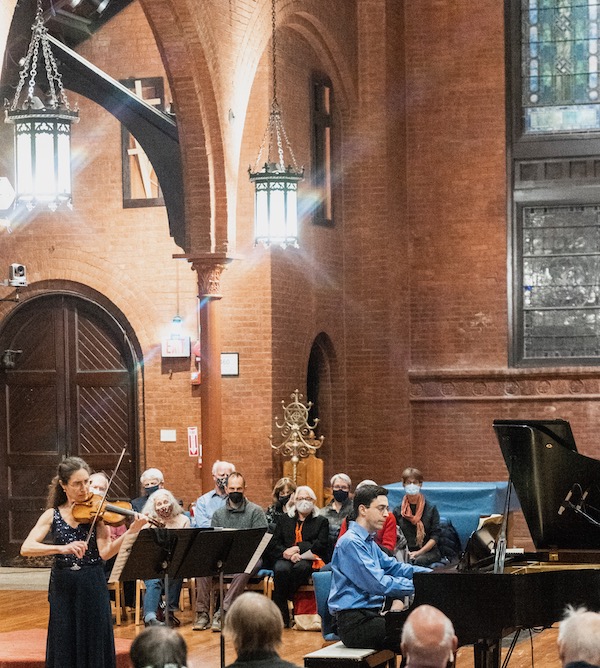Chiarina Chamber Players balance light and dark in engaging concert

Violinist Nurit Bar-Josef and pianist Efi Hackmey performed in the Chiarina Chamber Players concert Sunday night at St. Mark’s Episcopal Church. Photo: Winston Zhou
The Chiarina Chamber Players continue to amass a loyal following on Capitol Hill. Building on their livestreamed series during the pandemic, the group performed Sunday night, both for an in-person audience at St. Mark’s Episcopal Church and for listeners watching online. It is an innovative example of how ensembles and presenters may ultimately turn the challenges of the pandemic to their advantage.
Co-artistic director Carrie Bean Stute introduced the concert as the inaugural event in a new annual tradition honoring generous Chiarina supporter John Franzén, a long-time Capitol Hill resident who passed away in 2020. In another sign of the ensemble’s growing presence, co-artistic director Efi Hackmey announced a campaign to purchase a professional-quality Steinway for the series, seeded by a $62,700 grant from the D.C. Commission on the Arts and Humanities.
Hackmey then opened the program with three selections from Edvard Grieg’s Lyric Pieces. In the warm, pensive “Notturno,” Hackmey’s agile fingers fluttered over the avian twitters and trills that marked the midpoint of the piece and its end. More dizzying passagework followed in “Butterfly,” with its chromatic escapades upward and chaotic flapping motifs in dotting rhythms and oscillating chords. A muted drum-like pattern accompanied the rustic “Wedding Day at Troldhaugen,” a depiction of country life at the composer’s estate near Bergen.
Violinist Nurit Bar-Josef, concertmaster of the National Symphony Orchestra performed a solo piece, Jessie Montgomery’s Rhapsody No. 1. She explained that she had gotten to know the composer’s work when the NSO played some of her music last year. In the slow opening section, Bar-Josef melted in and out of double-stops with impeccable accuracy. More active figuration followed in a faster section, with a melody appearing amid dazzling arpeggiation, before the opening section returned, this time in part with the mute added to the strings.
The two musicians came together for William Grant Still’s Suite for Violin and Piano, in which each of three movements was inspired by a work created by a sculptor associated with the Harlem Renaissance. With bass octaves from Hackmey and Stravinsky-like rhythmic drive from Bar-Josef, the first movement recalled Richmond Barthé’s African Dancer, a 1933 plaster figure, mostly nude except for a loincloth of leaves. With her head thrown back, eyes closed, and arms loose, this statue seems lost in ecstasy, which seemed to correspond most to the bluesy turn in the middle section of the music.
In the second movement, Bar-Josef produced a molasses-rich sound on the G string, a maternal lullaby echoing the Mother and Child sculpture by Sargent Johnson. Bar-Josef glowed just as serenely high on the E string after the first section’s climax, with both players rising to the challenge of the more turbulent middle section. The duo excelled in the sassy third movement, inspired by Augusta Savage’s Gamin, with blues scales and rollicking rhythms giving life to the sculpture of a streetwise boy, his hat turned cockily to one side.
The program pivoted from light to dark after intermission, with Sergei Prokofiev’s Violin Sonata No. 1. Composed from 1938 to 1946, it is one of the composer’s more anxious wartime pieces. Hackmey brought out the ominous, booming side of the piano part with full and dark sound in the first movement. Bar-Josef responded with buzzing trills and intense, keening double-stops, although her muted runs were perhaps too pretty to be creepy in the section the composer described as “like the wind through a graveyard.”
Both musicians hammered the brutal repeated-note motifs running through the second movement, evoking machine-gun fire or blasting artillery. Bar-Josef’s full-throated shrieks on the violin and the dissonant clusters built up between the two instruments added to the sense of a harrowing scene, with savage violence on every side. Darkness even remained in the more tender third movement, with a poignant interchange of longing melodies. The muted violin wove its meandering main theme, set in tar-dark G string sound, into the piano’s treble figuration.
The finale began playfully, in a mood perhaps celebratory or just chaotic, as if the fog of war had lifted. The coordination between the two musicians was flawless, with the amassing of pizzicato notes, sawed runs, thundering octaves increasingly manic. Near the end, Bar-Josef’s second take on those “graveyard wind” runs shivered in a hair-raising hush, as if to say that death is still at hand.
Soprano Laura Strickling joins Chiarina Chamber Players 7:30 p.m. January 23, 2022. The program includes Schoenberg’s Pierrot Lunaire and Four Songs, plus The Jet Whistle by Villa-Lobos and the trio version of Stravinsky’s Soldier’s Tale. chiarina.org
